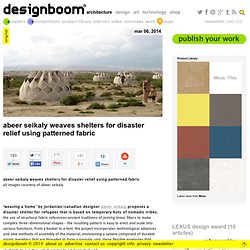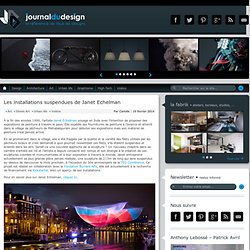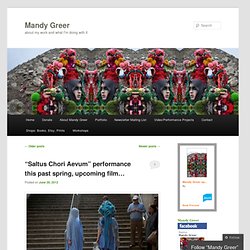

Nasir ol-Molk à Chiraz, mosquée kaléidoscope. Chiraz, ville du sud-ouest de l’Iran abrite quelques bijoux architecturaux dont la mosquée Nasir ol-Molk.

Construite au XIXème siècle, elle a été restaurée en 2011. Au-delà de sa beauté extérieure, c’est en son sein que le trésor se trouve ! Composée de magnifiques vitraux, chose assez rare pour une mosquée, elle offre au lever du soleil un intérieur bariolé et kaléidoscopique incroyable ! Arcades, niches, colonnes, mosaïques tout s’illumine le temps d’un instant. Voici en images un aperçu de ce spectacle unique.
Photos: Mohammad Reza Domiri Ganji, Dav Wong, Amin Abedini, Marinela T. Pin It Pin It. Abeer seikaly weaves shelters for disaster relief using patterned fabric. Mar 06, 2014 abeer seikaly weaves shelters for disaster relief using patterned fabric abeer seikaly weaves shelters for disaster relief using patterned fabricall images courtesy of abeer seikaly ‘weaving a home’ by jordanian/canadian designer abeer seikaly proposes a disaster shelter for refugees that is based on temporary huts of nomadic tribes. the use of structural fabric references ancient traditions of joining linear fibers to make complex three-dimensional shapes – the resulting pattern is easy to erect and scale into various functions, from a basket to a tent. the project incorporates technological advances and new methods of assembly of the material, envisioning a system composed of durable plastic members that are threaded to form a singular unit. these flexible envelopes fold across a central axis, with the hollow structural skin enabling necessities such as water and electricity to run through it, similar to a typical stud wall. view of the tent structures closed during winter.

Les installations suspendues de Janet Echelman. À la fin des années 1990, l’artiste Janet Echelman voyage en Inde avec l’intention de proposer des expositions de peinture à travers le pays.

Elle expédie ses fournitures de peinture à l’avance et atterrit dans le village de pêcheurs de Mahabalipuram pour débuter ses expositions mais son matériel de peinture n’est jamais arrivé. En se promenant dans le village, elle a été frappée par la qualité et la variété des filets utilisés par les pêcheurs locaux et s’est demandé à quoi pourrait ressembler ces filets, s’ils étaient suspendus et éclairés dans les airs. Serait-ce une nouvelle approche de la sculpture ? Un nouveau chapitre dans sa carrière d’artiste est né et l’artiste a depuis consacré son temps et son énergie à la création de ces sculptures colorées et monumentales et à leur exposition à travers le monde. Pour en savoir plus sur Janet Echelman, cliquez ici. Pin It. About my work and what I'm doing with it. I am delightfully busy now until September 2nd at The Project Room!

I’ve just updated the events calendar, so please join me if you are in Seattle, or please follow along on the Solstenen project blog! Back to work for me! Solstenen events at The Project Room will include weekly community crochet parties, and beginning in August, a variety of guest artist events and activities. These events will be updated on the calendar on an on-going basis. Get updates through Twitter or Facebook, too! Mia Pearlman - Cloudscapes. KNIT STOOLS : Claire. Sebastien preschoux. 'Trafaria Praia' by Joana Vasconcelos // Venice Biennale 2013.Yellowtrace — Interior Design, Architecture, Art, Photography, Lifestyle & Design Culture Blog. LACE FENCE is a design of Dutch Design House Demakersvan. It is s a high-end metal fabric that gives new insights in how you can create unique environments. Categoría Arquitectura textil. Exposición El Arte de Rosanjin (Museo Guimet de París) / “L’art de Rosanjin” exhibition (Guimet Museum in Paris).

Paris – France (2013). Diseño del montaje expositivo, Ryusuke Nanki. Fotografías, Ryusuke Nanki. Como mostrar la concepción estética del artista japones Rosanjin Kitaoji (1883-1959), una forma de vida que sitúa la experiencia artística en la vivencia del presente tan cotidiano como excepcional. Todo los que nos rodea, todo lo que existe en nuestro espacio vital, puede ser observado y aprendido, puede ser objeto activo del conocimiento empírico. En la existencia propia y personal del presente se encuentra el conocimiento de todas cosas, en ella coinciden la expresión y el sentido de una experiencia vital completa, que se traduce en la acción misma de interpretar una y otra vez esta realidad que nos envuelve. La casa que habita en el instante fugaz del tiempo presente, se hace con la silueta temporalmente condensadas por la luz, entre las membranas de organdí. Más información: